The appearance of psoriasis on the face is a rare and atypical phenomenon. Its main danger is not physiological, but psychological. A person faced with such a course of the disease often withdraws, experiences difficulties in communication and risks falling into severe depression. In the meantime, the problem can be solved by achieving a stable long-term remission. The main thing is to consult a specialist in time, and not to self-medicate.
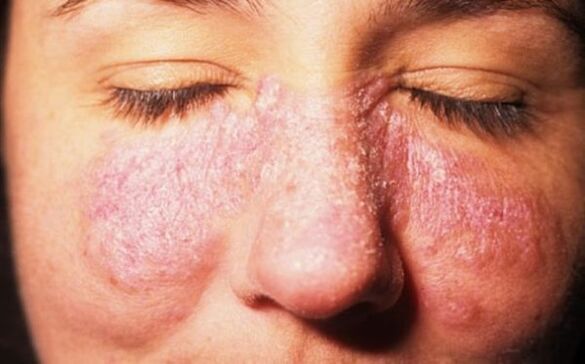
What is psoriasis?
Psoriasis is a chronic disease of a non-infectious nature, accompanied by very unpleasant symptoms, including reddish redness and peeling of damaged skin areas.
They arise due to a disruption in the mechanism of replacement of the dermis layer. In a healthy person, this process takes an average of 30 days, in a sick person, the skin is renewed in less than a week. The body perceives such a rapid formation of new cells as an aggressive invasion and gives an immune response, "sending" an increased number of leukocytes and red blood cells to the site of potential damage, which provokes inflammation.
Most often, the characteristic rashes of the disease are formed on the elbows and knees, armpits and on the head under the hair. In rare cases, the manifestations of the pathology spread to the face. Scientists are still understanding the causes and mechanisms of the disease.
Psoriasis causes and risk factors
In the scientific community, there has been debate about the nature of psoriasis for several decades. Three theories of the occurrence of the disease are most widespread:
- autoimmune;
- endocrine;
- psychosomatic.
In recent years, a genetic explanation for the occurrence of psoriasis has gained popularity. This is confirmed by statistical data, according to which most patients have close relatives who suffer from this disease.
Proponents of different theories agree on three points:
- the polyetiological nature of psoriasis, that is, the origin of the pathology is caused by several reasons;
- the disease is not contagious;
- it is possible to achieve stable remission.
Doctors have also identified the main factors that provoke the disease. Among them:
- chronic inflammation;
- serious traumatic skin damage;
- metabolic disorders;
- severe poisoning;
- weak immunity;
- constant stress;
- freezing;
- infectious diseases;
- alcoholism;
- certain medications (such as beta blockers and antibiotics).
People whose bodies are affected by more than two factors from the list above are at greater risk. There is a possibility that they will encounter the most unpleasant and atypical form of the disease.
The mechanism of facial psoriasis
Psoriasis on the face is characterized by rapid development due to particularly sensitive skin. It happens in different ways, but doctors distinguish three general stages:
- progressive;
- stationary;
- in regression.
In the last stage, psoriatic manifestations fade and disappear completely. The whole process, depending on the severity and type of the disease, lasts from two to six months.
The classification of psoriasis is complex and includes many varieties. Based on the type of progression, two large groups are conventionally distinguished: pustular (with rash in the form of purulent pustules) and non-pustular. According to the severity, the area of damage and the intensity of the manifestations, psoriasis can be mild and severe. The severe form of characteristic psoriasis of the face, seborrheic, is not part of the general classification.
Careful! A dangerous complication of this form of the disease is infection of the sebaceous glands by fungi.
The symptoms of the subtypes of psoriasis are clearly visible, which allows a competent doctor to accurately diagnose the disease and prescribe adequate treatment.
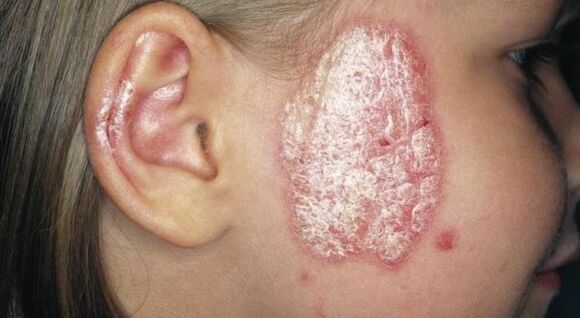
Symptoms of psoriasis on the face
The signs of the initial stage of the disease can easily be confused with the symptoms of an allergy or irritation. Moreover, they appear on the face during the periods of greatest skin vulnerability - in the autumn-winter period. Psoriasis can be suspected based on the following symptoms:
- skin rash;
- appearance of dandruff;
- itching;
- small wounds;
- peeling;
- yellow crust formation.
The first spots are no bigger than the head of a pin and appear on the forehead and cheeks. Then they grow and, joining each other, turn into red papules that itch a lot.
Careful! Scratching the rash accelerates the spread of the papules, which can leave scars.
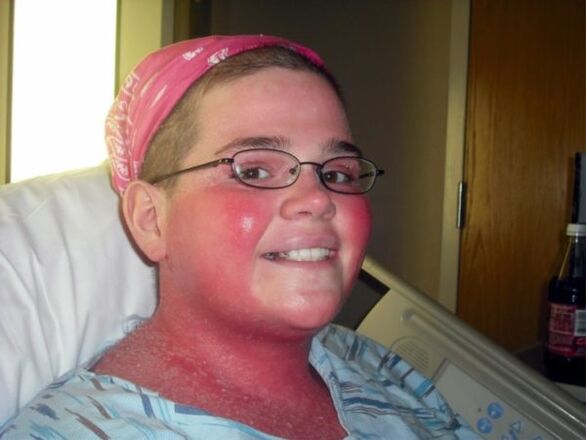
Gradually, the papules cover larger and larger areas of the skin and form on the lips, nose, ears and scalp. Plaques begin to bleed when pressed; the scales stick together from the secretion of the sebaceous glands, forming a dense yellow crust. The epidermis becomes thinner and loses its ability to perform protective functions from external influences. It is better to start treatment at an early stage of the disease. Only a dermatologist can determine the degree and type of the disease.
Differential diagnosis
Establishing the correct diagnosis is not difficult for a competent specialist. It is based on data on symptoms and the course of the disease, as well as on visual examination. The so-called psoriatic triad, which is discovered during the process of scratching the problem area of the skin, has a great diagnostic value. It includes three phenomena:
- stearin stain (skin growth after scratching);
- terminal film - a smooth surface instead of removed scales;
- blood dew - the appearance of bloody drops.
Psoriasis sometimes looks similar to other diseases. Differential diagnosis is often performed with pathologies such as:
- syphilis;
- some types of lichens;
- pityriasis;
- chronic dermatitis;
- eczema;
- parapsoriasis.
To clarify the diagnosis in controversial cases, the following are described:
- allergy tests;
- blood test for biochemistry;
- histological examination of the skin;
- UAC;
- stool examination for dysbacteriosis;
- Ultrasound;
- x-ray (to rule out psoriatic arthritis).
Unfortunately, after discovering the first signs of psoriasis on the face, many patients begin to self-medicate, which only worsens the situation. Meanwhile, modern medicine offers enough tools and techniques with which you can forget about an unpleasant disease for a long time.
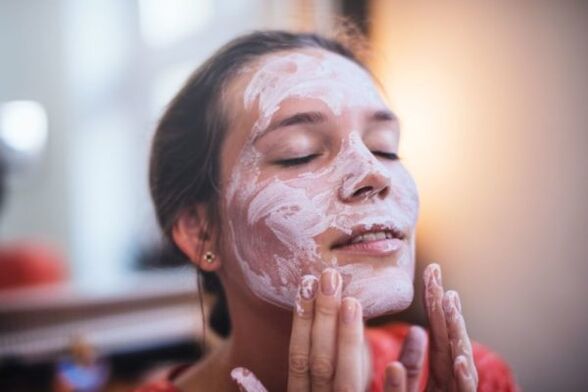
Treatment tactics
To successfully get rid of psoriasis, an integrated approach and strict adherence to medical recommendations is required. Commonly used treatment methods include:
- drug therapy;
- local influence;
- phototherapy;
- physiotherapy;
- folk remedies.
It is also important to follow a special diet.
Drug treatment
Pharmaceutical drugs are prescribed for the treatment of seborrheic psoriasis on the face in an advanced form. The following groups of drugs are commonly used:
- antimicrobials help reduce the intensity of psoriatic manifestations;
- a medicine with succinic acid normalizes cellular immunity and increases oxygen flow to tissues;
- antihistamines reduce itching and swelling;
- glucocorticosteroids;
- tranquilizers are included in complex treatment to relieve stress. You can take extracts of valerian or motherwort;
- Folic acid helps to normalize pigmentation and clean the skin.
Careful! Any medication should be taken strictly as prescribed by your doctor.
If the use of these drugs does not bring a positive result, use Cyclosporine. It is prescribed in the most severe cases due to the large number of side effects.
Local agents
Ointments, creams and gels in the treatment of psoriasis help relieve inflammation, soften plaques, help reduce itching and disinfect damaged facial skin. The most effective remedies include ointments:
- Salicylic acid;
- Naphthalene;
- Sulphur-tar.
In extremely severe cases, a dermatologist may recommend topical hormonal medications. They have a number of contraindications, so their independent use is strictly prohibited.
Careful! You cannot mask psoriatic plaques with cosmetics! It will block the pores and block the access of oxygen to the damaged tissues.
The effect of medicinal ointments is enhanced by the use of moisturizing and soothing preparations with shark oil or vitamin F. Physiotherapy will speed up the healing process.
Physiotherapy
In most cases, patients with psoriasis will have to undergo a course of phototherapy - this method restores the ability of tissues to regenerate by exposing the skin of the face to ultraviolet light and stimulating the production of vitamin D. Depending on the symptomsand characteristics of the course of the disease, such hardware manipulations as:
- X-ray therapy;
- Ural Federal District;
- electrosleep;
- laser exposure;
- ultrasound;
- magnetic therapy.
These procedures directly affect the foci of inflammation, contribute to their localization and elimination. It improves the general condition of the patient, including the psychological one. Recipes of traditional medicine will be a good addition to conservative treatment.
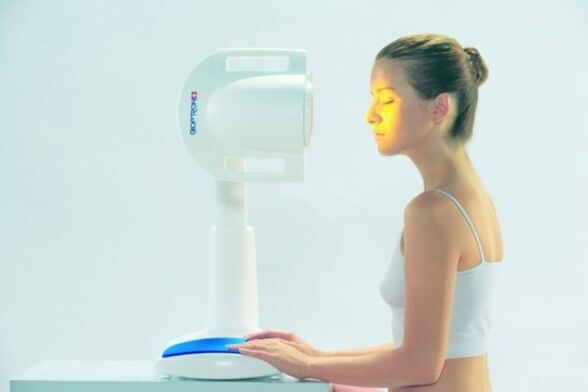
Folk remedies
Home remedies based on herbs and medicinal plants will help relieve the most unpleasant symptoms of the acute period of psoriasis. Here are some popular recipes:
- Brew a tablespoon of chamomile flowers with 200 g of hot water and let it brew (about an hour). In the cooled and filtered solution, wet a cotton cloth abundantly and apply it to the face for 30 minutes;
- combine solid oil and birch sap in equal proportions. Apply the resulting mass evenly to the affected areas and leave for 20 minutes. Wash and apply moisturizing cream to your face;
- Put some aloe leaves in the fridge for a week, then take them out, chop them up and apply them to your face for 30 minutes.
Essential oil based products and sea salt washes are very beneficial for psoriasis. In addition to taking care of your face, proper and balanced nutrition plays a big role in getting rid of psoriasis.
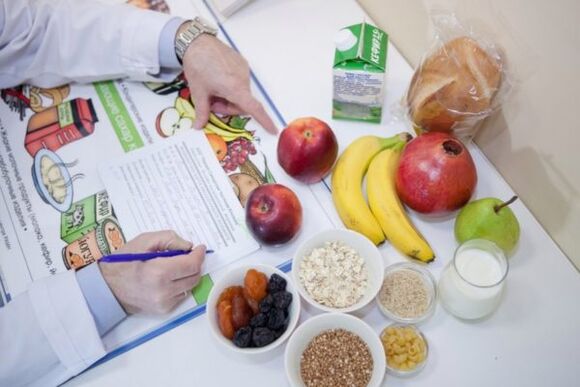
diets
Nutrition for psoriasis should include all the substances necessary for the body. It is especially important to eat more fiber. The diet should include a sufficient amount of fruits, vegetables and dairy products. You cannot eat:
- sweet baked goods;
- chocolates;
- milk with a high percentage of fat content;
- nuts;
- any citrus fruit;
- spices and herbs;
- alcoholic drink.
Dishes should not be greasy, fried, smoked or too spicy. Once a week it is worth organizing fasting days "on kefir".
Preventing
People who are predisposed to psoriasis should take simple precautions:
- wash with special products with a moisturizing effect;
- Wipe your face daily with decoctions based on chamomile or hops, especially in hot weather or frost;
- quit smoking;
- avoid prolonged stay in dusty or humid areas;
- spend more time in the sun.
Visit your dermatologist regularly to prevent the condition from worsening. It is impossible to completely cure psoriasis. However, by observing preventive measures and following medical recommendations, you can achieve lasting remission and lead a satisfying lifestyle.























